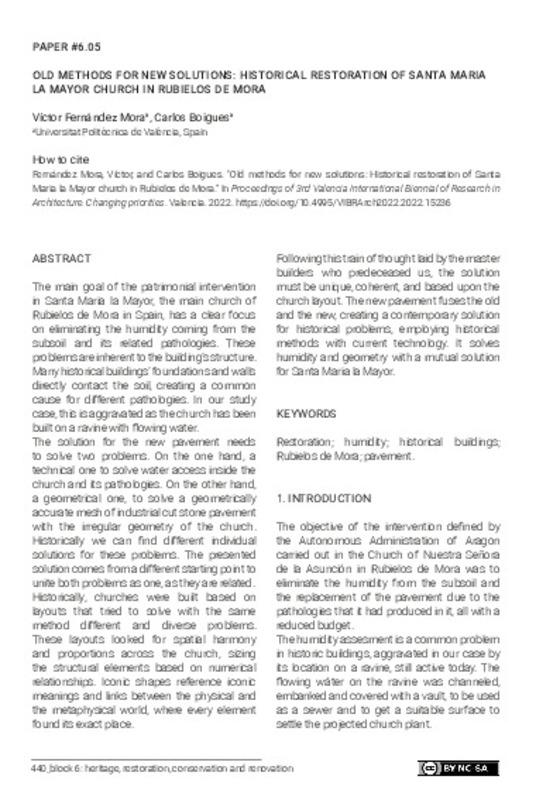JavaScript is disabled for your browser. Some features of this site may not work without it.
Buscar en RiuNet
Listar
Mi cuenta
Estadísticas
Ayuda RiuNet
Admin. UPV
Old methods for new solutions: Historical restoration of Santa Maria la Mayor church in Rubielos de Mora
Mostrar el registro sencillo del ítem
Ficheros en el ítem
| dc.contributor.author | Fernández Mora, Victor
|
es_ES |
| dc.contributor.author | Boigues, Carles
|
es_ES |
| dc.coverage.spatial | east=-0.6513901999999999; north=40.1899735; name=Santa María La Mayor, Rubielos de Mora, Teruel, Espanya | es_ES |
| dc.date.accessioned | 2023-12-21T12:45:50Z | |
| dc.date.available | 2023-12-21T12:45:50Z | |
| dc.date.issued | 2023-05-22 | |
| dc.identifier.isbn | 9788413960265 | |
| dc.identifier.uri | http://hdl.handle.net/10251/201022 | |
| dc.description.abstract | [EN] The main goal of the patrimonial intervention in Santa Maria la Mayor, the main church of Rubielos de Mora in Spain, has a clear focus on eliminating the humidity coming from the subsoil and its related pathologies. These problems are inherent to the building’s structure. Many historical buildings’ foundations and walls directly contact the soil, creating a common cause for different pathologies. In our study case, this is aggravated as the church has been built on a ravine with flowing water.The solution for the new pavement needs to solve two problems. On the one hand, a technical one to solve water access inside the church and its pathologies. On the other hand, a geometrical one, to solve a geometrically accurate mesh of industrial cut stone pavement with the irregular geometry of the church. Historically we can find different individual solutions for these problems. The presented solution comes from a different starting point to unite both problems as one, as they are related.Historically, churches were built based on layouts that tried to solve with the same method different and diverse problems. These layouts looked for spatial harmony and proportions across the church, sizing the structural elements based on numerical relationships. Iconic shapes reference iconic meanings and links between the physical and the metaphysical world, where every element found its exact place.Following this train of thought laid by the master builders who predeceased us, the solution must be unique, coherent, and based upon the church layout. The new pavement fuses the old and the new, creating a contemporary solution for historical problems, employing historical methods with current technology. It solves humidity and geometry with a mutual solution for Santa Maria la Mayor. | es_ES |
| dc.format.extent | 12 | es_ES |
| dc.language | Inglés | es_ES |
| dc.publisher | Editorial Universitat Politècnica de València | es_ES |
| dc.relation.ispartof | Proceedings - 3rd Valencia International Biennial of Research in Architecture, VIBRArch | |
| dc.rights | Reconocimiento - No comercial - Compartir igual (by-nc-sa) | es_ES |
| dc.subject | Restoration | es_ES |
| dc.subject | Humidity | es_ES |
| dc.subject | Historical buildings | es_ES |
| dc.subject | Rubielos de Mora | es_ES |
| dc.subject | Pavement | es_ES |
| dc.title | Old methods for new solutions: Historical restoration of Santa Maria la Mayor church in Rubielos de Mora | es_ES |
| dc.type | Capítulo de libro | es_ES |
| dc.type | Comunicación en congreso | es_ES |
| dc.identifier.doi | 10.4995/VIBRArch2022.2022.15236 | |
| dc.rights.accessRights | Abierto | es_ES |
| dc.description.bibliographicCitation | Fernández Mora, V.; Boigues, C. (2023). Old methods for new solutions: Historical restoration of Santa Maria la Mayor church in Rubielos de Mora. Editorial Universitat Politècnica de València. 440-451. https://doi.org/10.4995/VIBRArch2022.2022.15236 | es_ES |
| dc.description.accrualMethod | OCS | es_ES |
| dc.relation.conferencename | 3rd Valencia International Biennial of Research in Architecture, VIBRArch | es_ES |
| dc.relation.conferencedate | Noviembre 09-11, 2022 | es_ES |
| dc.relation.conferenceplace | Valencia, España | es_ES |
| dc.relation.publisherversion | http://ocs.editorial.upv.es/index.php/VIBRArch/VIBRArch2022/paper/view/15236 | es_ES |
| dc.description.upvformatpinicio | 440 | es_ES |
| dc.description.upvformatpfin | 451 | es_ES |
| dc.type.version | info:eu-repo/semantics/publishedVersion | es_ES |
| dc.relation.pasarela | OCS\15236 | es_ES |








